Team Management Report: Effective Team Management Strategies Analysis
VerifiedAdded on 2020/10/04
|9
|2335
|292
Report
AI Summary
This report provides a comprehensive overview of team management, exploring key aspects such as effective team performance, team development stages, and the impact of group norms. It compares various team development models and analyzes barriers to success, conflict resolution methods, and strategies for establishing trust and accountability. The report further examines ways to promote a shared vision, encourage knowledge sharing, and implement a no-blame culture within a team. It also discusses different leadership and management styles, offering reflections on their practical application. The report concludes by highlighting the importance of team management in fostering growth, resolving conflicts, and creating a supportive work environment.
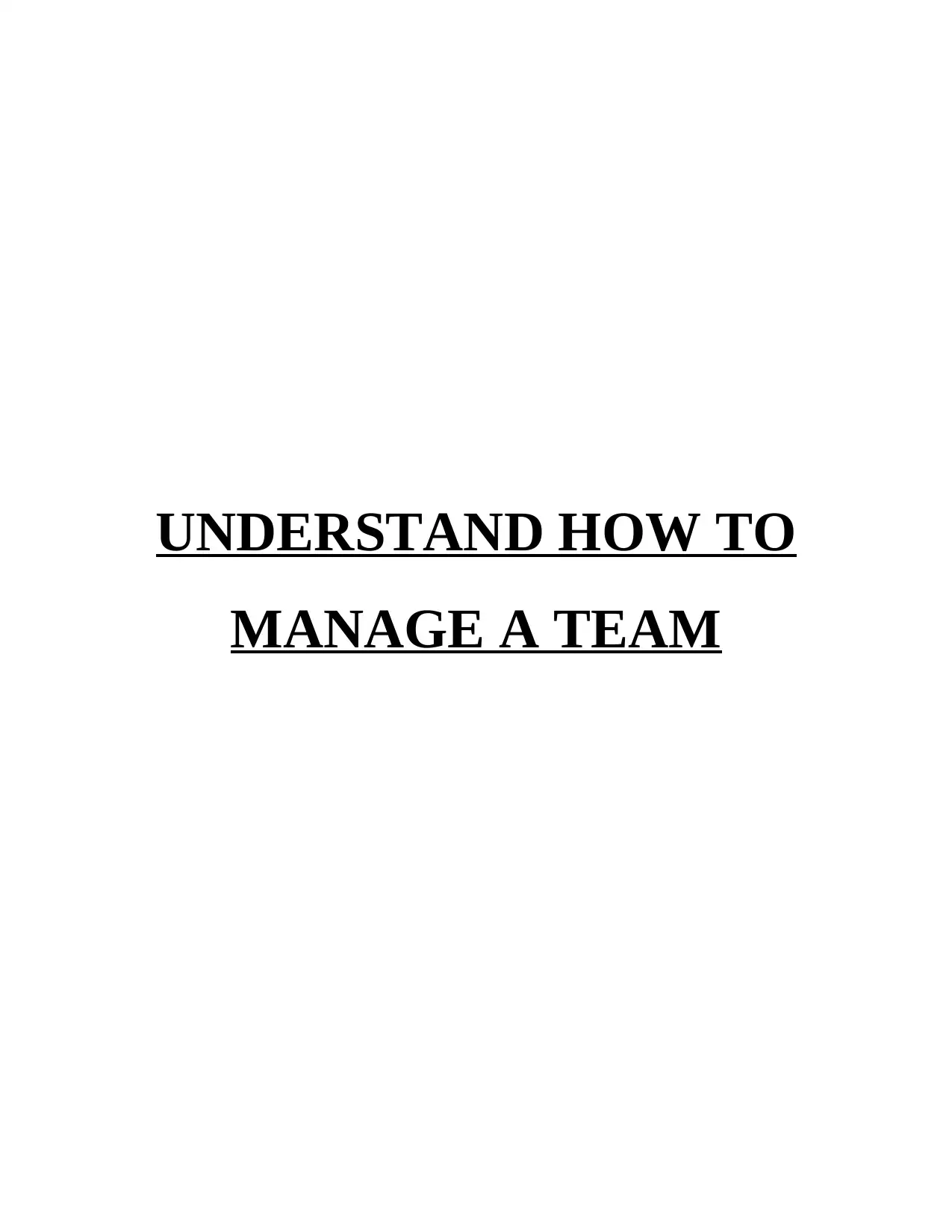
UNDERSTAND HOW TO
MANAGE A TEAM
MANAGE A TEAM
Paraphrase This Document
Need a fresh take? Get an instant paraphrase of this document with our AI Paraphraser
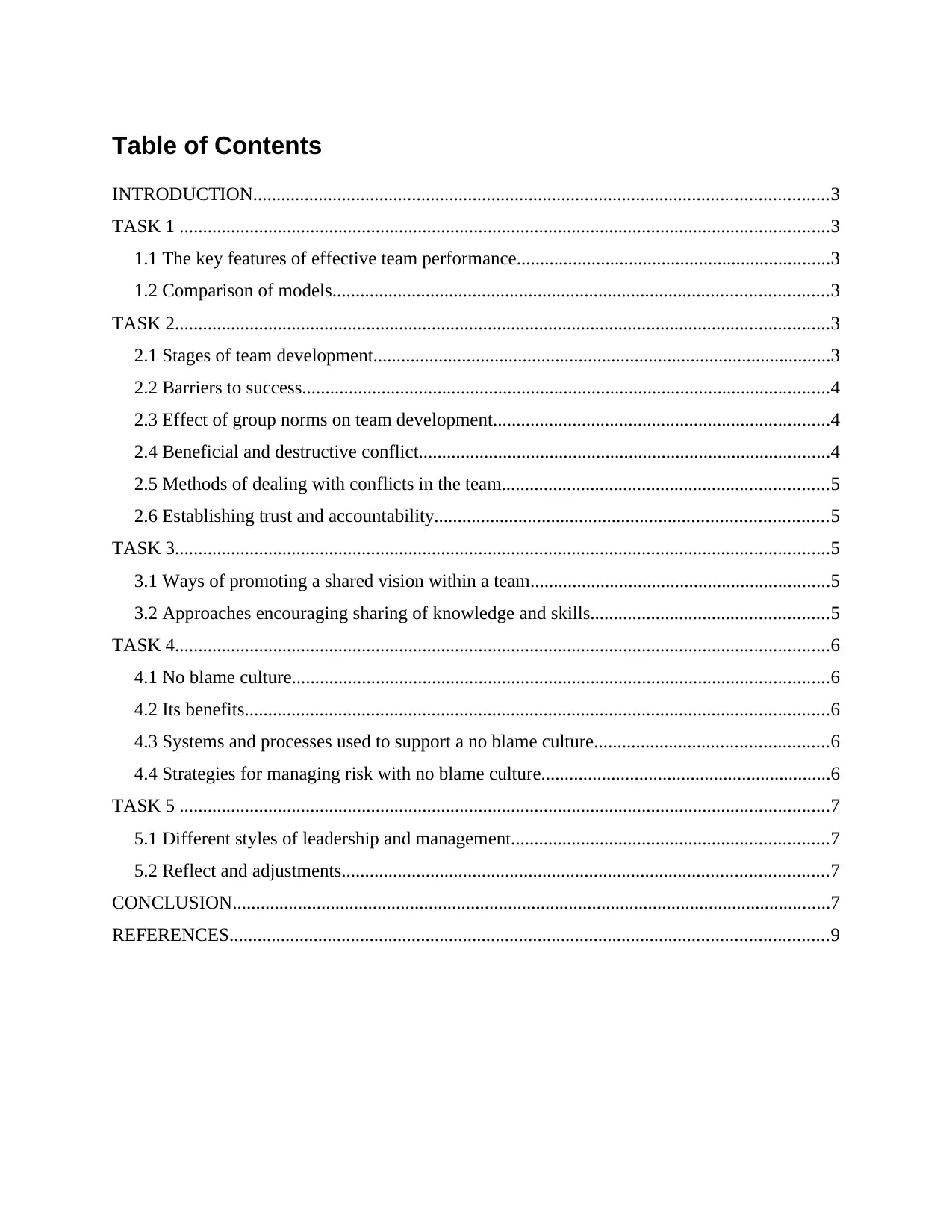
Table of Contents
INTRODUCTION...........................................................................................................................3
TASK 1 ...........................................................................................................................................3
1.1 The key features of effective team performance...................................................................3
1.2 Comparison of models..........................................................................................................3
TASK 2............................................................................................................................................3
2.1 Stages of team development..................................................................................................3
2.2 Barriers to success.................................................................................................................4
2.3 Effect of group norms on team development........................................................................4
2.4 Beneficial and destructive conflict........................................................................................4
2.5 Methods of dealing with conflicts in the team......................................................................5
2.6 Establishing trust and accountability....................................................................................5
TASK 3............................................................................................................................................5
3.1 Ways of promoting a shared vision within a team................................................................5
3.2 Approaches encouraging sharing of knowledge and skills...................................................5
TASK 4............................................................................................................................................6
4.1 No blame culture...................................................................................................................6
4.2 Its benefits.............................................................................................................................6
4.3 Systems and processes used to support a no blame culture..................................................6
4.4 Strategies for managing risk with no blame culture..............................................................6
TASK 5 ...........................................................................................................................................7
5.1 Different styles of leadership and management....................................................................7
5.2 Reflect and adjustments........................................................................................................7
CONCLUSION................................................................................................................................7
REFERENCES................................................................................................................................9
INTRODUCTION...........................................................................................................................3
TASK 1 ...........................................................................................................................................3
1.1 The key features of effective team performance...................................................................3
1.2 Comparison of models..........................................................................................................3
TASK 2............................................................................................................................................3
2.1 Stages of team development..................................................................................................3
2.2 Barriers to success.................................................................................................................4
2.3 Effect of group norms on team development........................................................................4
2.4 Beneficial and destructive conflict........................................................................................4
2.5 Methods of dealing with conflicts in the team......................................................................5
2.6 Establishing trust and accountability....................................................................................5
TASK 3............................................................................................................................................5
3.1 Ways of promoting a shared vision within a team................................................................5
3.2 Approaches encouraging sharing of knowledge and skills...................................................5
TASK 4............................................................................................................................................6
4.1 No blame culture...................................................................................................................6
4.2 Its benefits.............................................................................................................................6
4.3 Systems and processes used to support a no blame culture..................................................6
4.4 Strategies for managing risk with no blame culture..............................................................6
TASK 5 ...........................................................................................................................................7
5.1 Different styles of leadership and management....................................................................7
5.2 Reflect and adjustments........................................................................................................7
CONCLUSION................................................................................................................................7
REFERENCES................................................................................................................................9
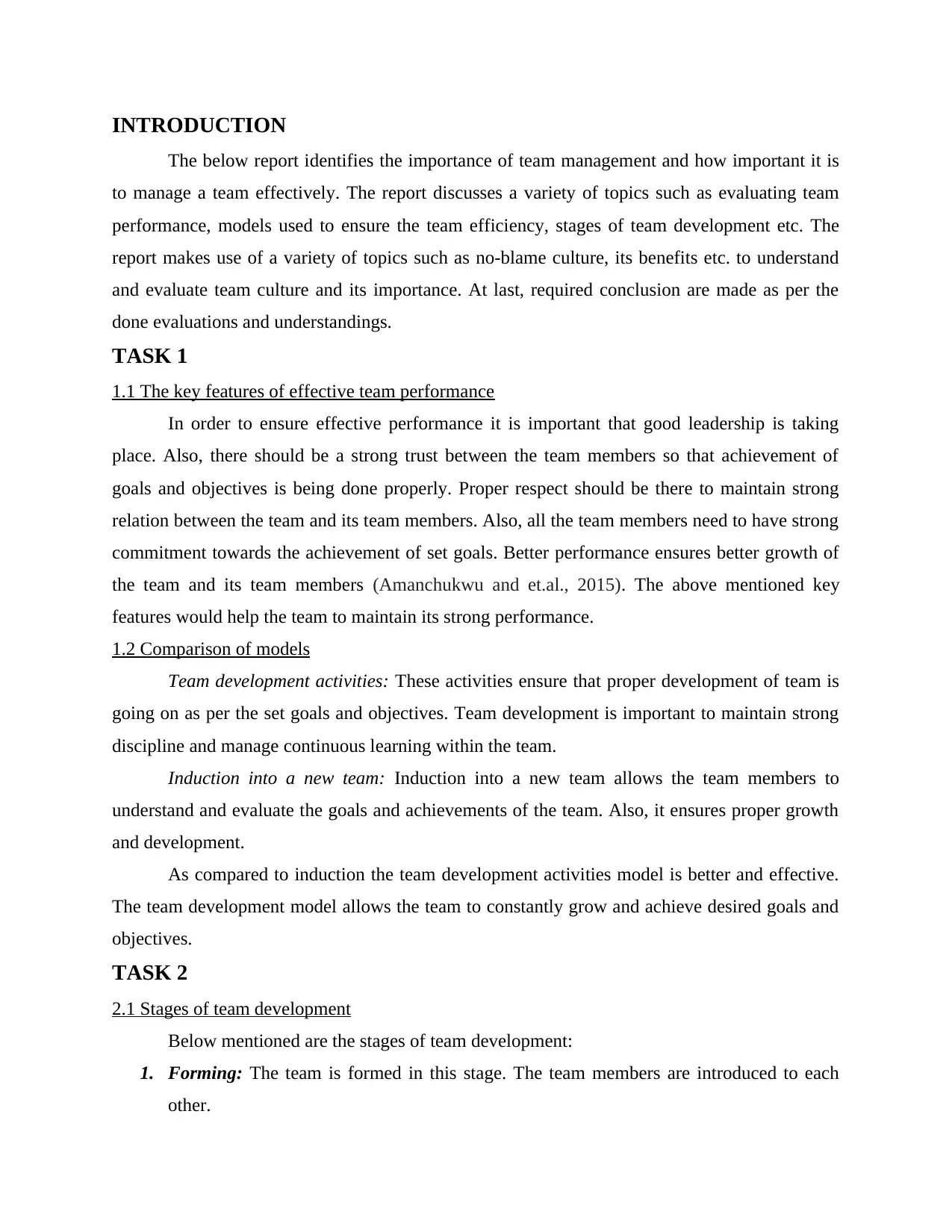
INTRODUCTION
The below report identifies the importance of team management and how important it is
to manage a team effectively. The report discusses a variety of topics such as evaluating team
performance, models used to ensure the team efficiency, stages of team development etc. The
report makes use of a variety of topics such as no-blame culture, its benefits etc. to understand
and evaluate team culture and its importance. At last, required conclusion are made as per the
done evaluations and understandings.
TASK 1
1.1 The key features of effective team performance
In order to ensure effective performance it is important that good leadership is taking
place. Also, there should be a strong trust between the team members so that achievement of
goals and objectives is being done properly. Proper respect should be there to maintain strong
relation between the team and its team members. Also, all the team members need to have strong
commitment towards the achievement of set goals. Better performance ensures better growth of
the team and its team members (Amanchukwu and et.al., 2015). The above mentioned key
features would help the team to maintain its strong performance.
1.2 Comparison of models
Team development activities: These activities ensure that proper development of team is
going on as per the set goals and objectives. Team development is important to maintain strong
discipline and manage continuous learning within the team.
Induction into a new team: Induction into a new team allows the team members to
understand and evaluate the goals and achievements of the team. Also, it ensures proper growth
and development.
As compared to induction the team development activities model is better and effective.
The team development model allows the team to constantly grow and achieve desired goals and
objectives.
TASK 2
2.1 Stages of team development
Below mentioned are the stages of team development:
1. Forming: The team is formed in this stage. The team members are introduced to each
other.
The below report identifies the importance of team management and how important it is
to manage a team effectively. The report discusses a variety of topics such as evaluating team
performance, models used to ensure the team efficiency, stages of team development etc. The
report makes use of a variety of topics such as no-blame culture, its benefits etc. to understand
and evaluate team culture and its importance. At last, required conclusion are made as per the
done evaluations and understandings.
TASK 1
1.1 The key features of effective team performance
In order to ensure effective performance it is important that good leadership is taking
place. Also, there should be a strong trust between the team members so that achievement of
goals and objectives is being done properly. Proper respect should be there to maintain strong
relation between the team and its team members. Also, all the team members need to have strong
commitment towards the achievement of set goals. Better performance ensures better growth of
the team and its team members (Amanchukwu and et.al., 2015). The above mentioned key
features would help the team to maintain its strong performance.
1.2 Comparison of models
Team development activities: These activities ensure that proper development of team is
going on as per the set goals and objectives. Team development is important to maintain strong
discipline and manage continuous learning within the team.
Induction into a new team: Induction into a new team allows the team members to
understand and evaluate the goals and achievements of the team. Also, it ensures proper growth
and development.
As compared to induction the team development activities model is better and effective.
The team development model allows the team to constantly grow and achieve desired goals and
objectives.
TASK 2
2.1 Stages of team development
Below mentioned are the stages of team development:
1. Forming: The team is formed in this stage. The team members are introduced to each
other.
⊘ This is a preview!⊘
Do you want full access?
Subscribe today to unlock all pages.

Trusted by 1+ million students worldwide
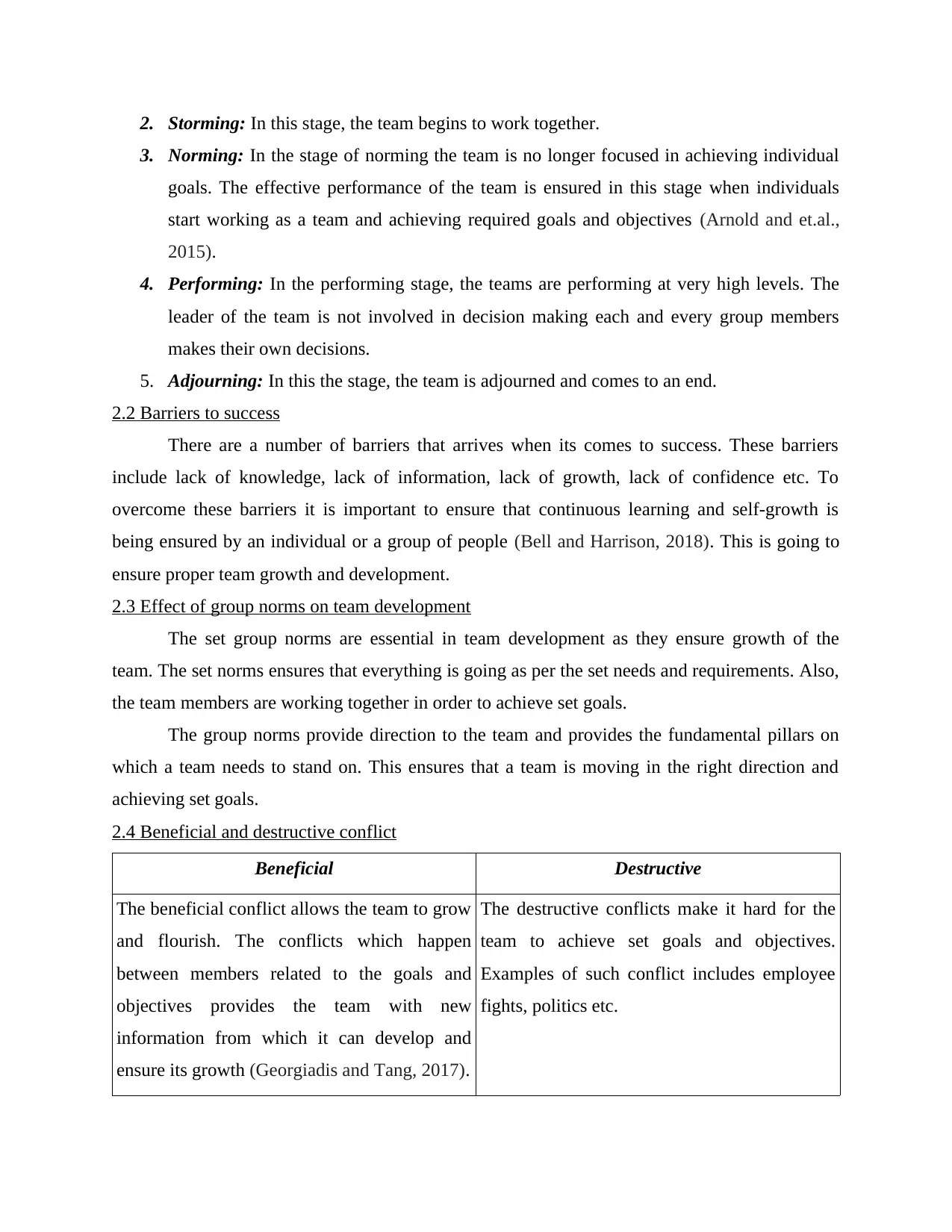
2. Storming: In this stage, the team begins to work together.
3. Norming: In the stage of norming the team is no longer focused in achieving individual
goals. The effective performance of the team is ensured in this stage when individuals
start working as a team and achieving required goals and objectives (Arnold and et.al.,
2015).
4. Performing: In the performing stage, the teams are performing at very high levels. The
leader of the team is not involved in decision making each and every group members
makes their own decisions.
5. Adjourning: In this the stage, the team is adjourned and comes to an end.
2.2 Barriers to success
There are a number of barriers that arrives when its comes to success. These barriers
include lack of knowledge, lack of information, lack of growth, lack of confidence etc. To
overcome these barriers it is important to ensure that continuous learning and self-growth is
being ensured by an individual or a group of people (Bell and Harrison, 2018). This is going to
ensure proper team growth and development.
2.3 Effect of group norms on team development
The set group norms are essential in team development as they ensure growth of the
team. The set norms ensures that everything is going as per the set needs and requirements. Also,
the team members are working together in order to achieve set goals.
The group norms provide direction to the team and provides the fundamental pillars on
which a team needs to stand on. This ensures that a team is moving in the right direction and
achieving set goals.
2.4 Beneficial and destructive conflict
Beneficial Destructive
The beneficial conflict allows the team to grow
and flourish. The conflicts which happen
between members related to the goals and
objectives provides the team with new
information from which it can develop and
ensure its growth (Georgiadis and Tang, 2017).
The destructive conflicts make it hard for the
team to achieve set goals and objectives.
Examples of such conflict includes employee
fights, politics etc.
3. Norming: In the stage of norming the team is no longer focused in achieving individual
goals. The effective performance of the team is ensured in this stage when individuals
start working as a team and achieving required goals and objectives (Arnold and et.al.,
2015).
4. Performing: In the performing stage, the teams are performing at very high levels. The
leader of the team is not involved in decision making each and every group members
makes their own decisions.
5. Adjourning: In this the stage, the team is adjourned and comes to an end.
2.2 Barriers to success
There are a number of barriers that arrives when its comes to success. These barriers
include lack of knowledge, lack of information, lack of growth, lack of confidence etc. To
overcome these barriers it is important to ensure that continuous learning and self-growth is
being ensured by an individual or a group of people (Bell and Harrison, 2018). This is going to
ensure proper team growth and development.
2.3 Effect of group norms on team development
The set group norms are essential in team development as they ensure growth of the
team. The set norms ensures that everything is going as per the set needs and requirements. Also,
the team members are working together in order to achieve set goals.
The group norms provide direction to the team and provides the fundamental pillars on
which a team needs to stand on. This ensures that a team is moving in the right direction and
achieving set goals.
2.4 Beneficial and destructive conflict
Beneficial Destructive
The beneficial conflict allows the team to grow
and flourish. The conflicts which happen
between members related to the goals and
objectives provides the team with new
information from which it can develop and
ensure its growth (Georgiadis and Tang, 2017).
The destructive conflicts make it hard for the
team to achieve set goals and objectives.
Examples of such conflict includes employee
fights, politics etc.
Paraphrase This Document
Need a fresh take? Get an instant paraphrase of this document with our AI Paraphraser
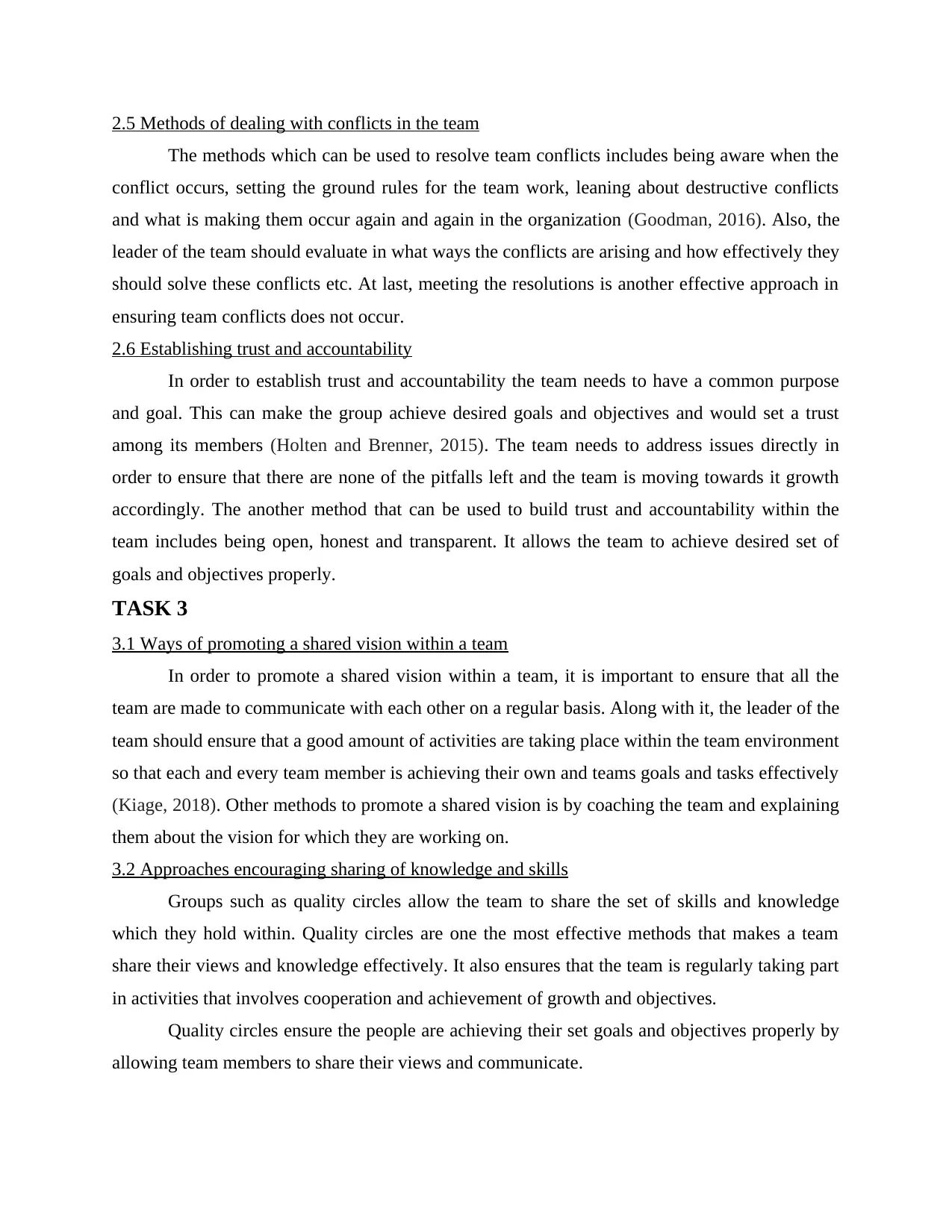
2.5 Methods of dealing with conflicts in the team
The methods which can be used to resolve team conflicts includes being aware when the
conflict occurs, setting the ground rules for the team work, leaning about destructive conflicts
and what is making them occur again and again in the organization (Goodman, 2016). Also, the
leader of the team should evaluate in what ways the conflicts are arising and how effectively they
should solve these conflicts etc. At last, meeting the resolutions is another effective approach in
ensuring team conflicts does not occur.
2.6 Establishing trust and accountability
In order to establish trust and accountability the team needs to have a common purpose
and goal. This can make the group achieve desired goals and objectives and would set a trust
among its members (Holten and Brenner, 2015). The team needs to address issues directly in
order to ensure that there are none of the pitfalls left and the team is moving towards it growth
accordingly. The another method that can be used to build trust and accountability within the
team includes being open, honest and transparent. It allows the team to achieve desired set of
goals and objectives properly.
TASK 3
3.1 Ways of promoting a shared vision within a team
In order to promote a shared vision within a team, it is important to ensure that all the
team are made to communicate with each other on a regular basis. Along with it, the leader of the
team should ensure that a good amount of activities are taking place within the team environment
so that each and every team member is achieving their own and teams goals and tasks effectively
(Kiage, 2018). Other methods to promote a shared vision is by coaching the team and explaining
them about the vision for which they are working on.
3.2 Approaches encouraging sharing of knowledge and skills
Groups such as quality circles allow the team to share the set of skills and knowledge
which they hold within. Quality circles are one the most effective methods that makes a team
share their views and knowledge effectively. It also ensures that the team is regularly taking part
in activities that involves cooperation and achievement of growth and objectives.
Quality circles ensure the people are achieving their set goals and objectives properly by
allowing team members to share their views and communicate.
The methods which can be used to resolve team conflicts includes being aware when the
conflict occurs, setting the ground rules for the team work, leaning about destructive conflicts
and what is making them occur again and again in the organization (Goodman, 2016). Also, the
leader of the team should evaluate in what ways the conflicts are arising and how effectively they
should solve these conflicts etc. At last, meeting the resolutions is another effective approach in
ensuring team conflicts does not occur.
2.6 Establishing trust and accountability
In order to establish trust and accountability the team needs to have a common purpose
and goal. This can make the group achieve desired goals and objectives and would set a trust
among its members (Holten and Brenner, 2015). The team needs to address issues directly in
order to ensure that there are none of the pitfalls left and the team is moving towards it growth
accordingly. The another method that can be used to build trust and accountability within the
team includes being open, honest and transparent. It allows the team to achieve desired set of
goals and objectives properly.
TASK 3
3.1 Ways of promoting a shared vision within a team
In order to promote a shared vision within a team, it is important to ensure that all the
team are made to communicate with each other on a regular basis. Along with it, the leader of the
team should ensure that a good amount of activities are taking place within the team environment
so that each and every team member is achieving their own and teams goals and tasks effectively
(Kiage, 2018). Other methods to promote a shared vision is by coaching the team and explaining
them about the vision for which they are working on.
3.2 Approaches encouraging sharing of knowledge and skills
Groups such as quality circles allow the team to share the set of skills and knowledge
which they hold within. Quality circles are one the most effective methods that makes a team
share their views and knowledge effectively. It also ensures that the team is regularly taking part
in activities that involves cooperation and achievement of growth and objectives.
Quality circles ensure the people are achieving their set goals and objectives properly by
allowing team members to share their views and communicate.
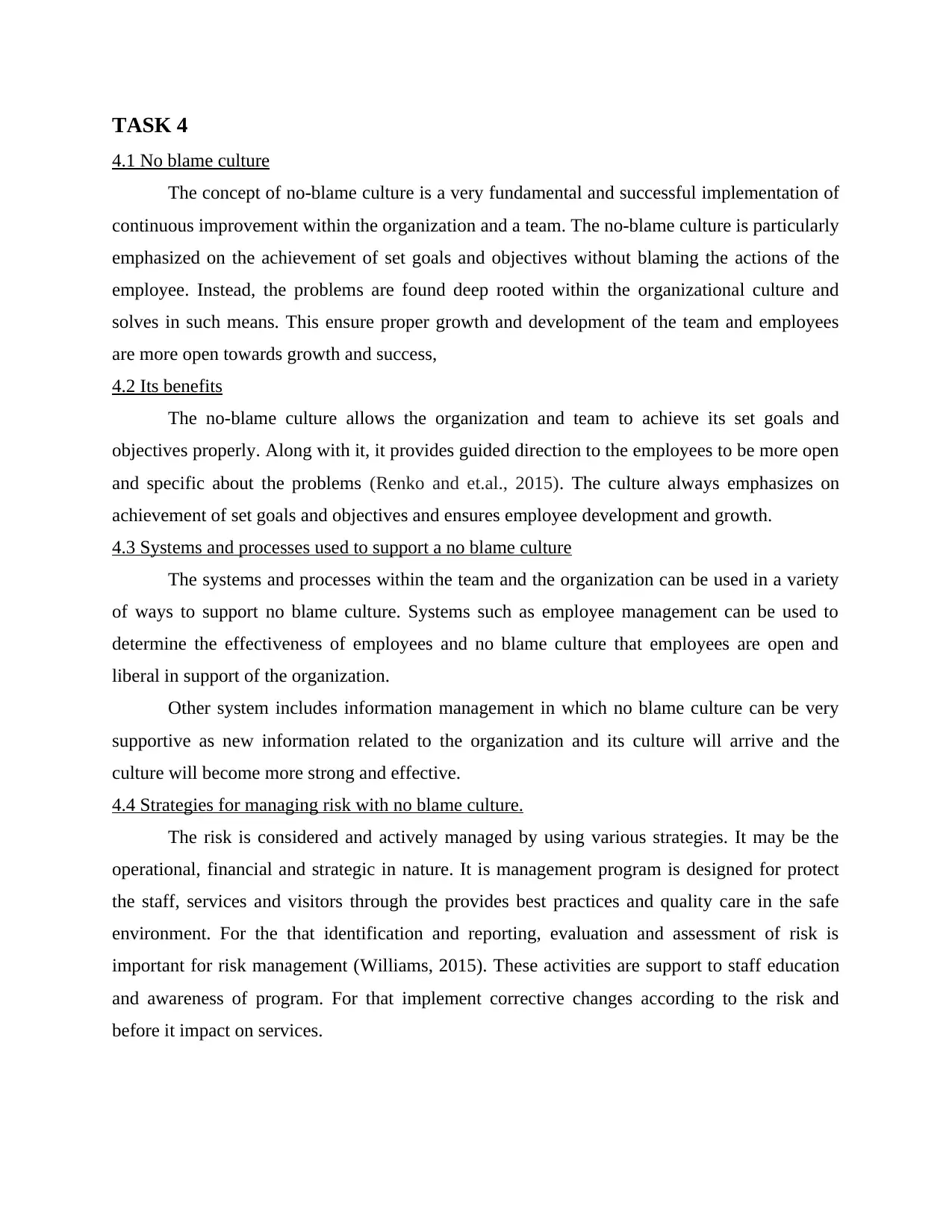
TASK 4
4.1 No blame culture
The concept of no-blame culture is a very fundamental and successful implementation of
continuous improvement within the organization and a team. The no-blame culture is particularly
emphasized on the achievement of set goals and objectives without blaming the actions of the
employee. Instead, the problems are found deep rooted within the organizational culture and
solves in such means. This ensure proper growth and development of the team and employees
are more open towards growth and success,
4.2 Its benefits
The no-blame culture allows the organization and team to achieve its set goals and
objectives properly. Along with it, it provides guided direction to the employees to be more open
and specific about the problems (Renko and et.al., 2015). The culture always emphasizes on
achievement of set goals and objectives and ensures employee development and growth.
4.3 Systems and processes used to support a no blame culture
The systems and processes within the team and the organization can be used in a variety
of ways to support no blame culture. Systems such as employee management can be used to
determine the effectiveness of employees and no blame culture that employees are open and
liberal in support of the organization.
Other system includes information management in which no blame culture can be very
supportive as new information related to the organization and its culture will arrive and the
culture will become more strong and effective.
4.4 Strategies for managing risk with no blame culture.
The risk is considered and actively managed by using various strategies. It may be the
operational, financial and strategic in nature. It is management program is designed for protect
the staff, services and visitors through the provides best practices and quality care in the safe
environment. For the that identification and reporting, evaluation and assessment of risk is
important for risk management (Williams, 2015). These activities are support to staff education
and awareness of program. For that implement corrective changes according to the risk and
before it impact on services.
4.1 No blame culture
The concept of no-blame culture is a very fundamental and successful implementation of
continuous improvement within the organization and a team. The no-blame culture is particularly
emphasized on the achievement of set goals and objectives without blaming the actions of the
employee. Instead, the problems are found deep rooted within the organizational culture and
solves in such means. This ensure proper growth and development of the team and employees
are more open towards growth and success,
4.2 Its benefits
The no-blame culture allows the organization and team to achieve its set goals and
objectives properly. Along with it, it provides guided direction to the employees to be more open
and specific about the problems (Renko and et.al., 2015). The culture always emphasizes on
achievement of set goals and objectives and ensures employee development and growth.
4.3 Systems and processes used to support a no blame culture
The systems and processes within the team and the organization can be used in a variety
of ways to support no blame culture. Systems such as employee management can be used to
determine the effectiveness of employees and no blame culture that employees are open and
liberal in support of the organization.
Other system includes information management in which no blame culture can be very
supportive as new information related to the organization and its culture will arrive and the
culture will become more strong and effective.
4.4 Strategies for managing risk with no blame culture.
The risk is considered and actively managed by using various strategies. It may be the
operational, financial and strategic in nature. It is management program is designed for protect
the staff, services and visitors through the provides best practices and quality care in the safe
environment. For the that identification and reporting, evaluation and assessment of risk is
important for risk management (Williams, 2015). These activities are support to staff education
and awareness of program. For that implement corrective changes according to the risk and
before it impact on services.
⊘ This is a preview!⊘
Do you want full access?
Subscribe today to unlock all pages.

Trusted by 1+ million students worldwide
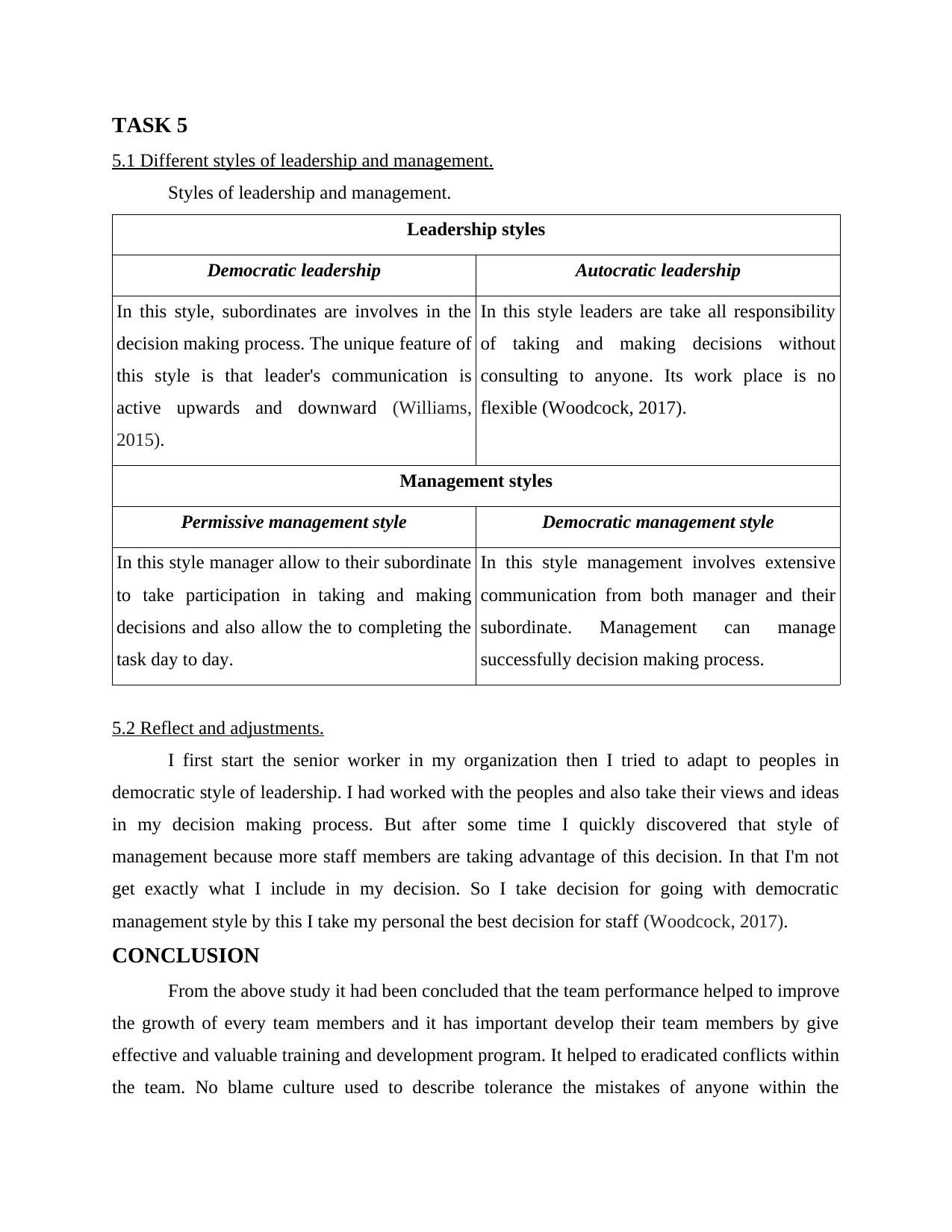
TASK 5
5.1 Different styles of leadership and management.
Styles of leadership and management.
Leadership styles
Democratic leadership Autocratic leadership
In this style, subordinates are involves in the
decision making process. The unique feature of
this style is that leader's communication is
active upwards and downward (Williams,
2015).
In this style leaders are take all responsibility
of taking and making decisions without
consulting to anyone. Its work place is no
flexible (Woodcock, 2017).
Management styles
Permissive management style Democratic management style
In this style manager allow to their subordinate
to take participation in taking and making
decisions and also allow the to completing the
task day to day.
In this style management involves extensive
communication from both manager and their
subordinate. Management can manage
successfully decision making process.
5.2 Reflect and adjustments.
I first start the senior worker in my organization then I tried to adapt to peoples in
democratic style of leadership. I had worked with the peoples and also take their views and ideas
in my decision making process. But after some time I quickly discovered that style of
management because more staff members are taking advantage of this decision. In that I'm not
get exactly what I include in my decision. So I take decision for going with democratic
management style by this I take my personal the best decision for staff (Woodcock, 2017).
CONCLUSION
From the above study it had been concluded that the team performance helped to improve
the growth of every team members and it has important develop their team members by give
effective and valuable training and development program. It helped to eradicated conflicts within
the team. No blame culture used to describe tolerance the mistakes of anyone within the
5.1 Different styles of leadership and management.
Styles of leadership and management.
Leadership styles
Democratic leadership Autocratic leadership
In this style, subordinates are involves in the
decision making process. The unique feature of
this style is that leader's communication is
active upwards and downward (Williams,
2015).
In this style leaders are take all responsibility
of taking and making decisions without
consulting to anyone. Its work place is no
flexible (Woodcock, 2017).
Management styles
Permissive management style Democratic management style
In this style manager allow to their subordinate
to take participation in taking and making
decisions and also allow the to completing the
task day to day.
In this style management involves extensive
communication from both manager and their
subordinate. Management can manage
successfully decision making process.
5.2 Reflect and adjustments.
I first start the senior worker in my organization then I tried to adapt to peoples in
democratic style of leadership. I had worked with the peoples and also take their views and ideas
in my decision making process. But after some time I quickly discovered that style of
management because more staff members are taking advantage of this decision. In that I'm not
get exactly what I include in my decision. So I take decision for going with democratic
management style by this I take my personal the best decision for staff (Woodcock, 2017).
CONCLUSION
From the above study it had been concluded that the team performance helped to improve
the growth of every team members and it has important develop their team members by give
effective and valuable training and development program. It helped to eradicated conflicts within
the team. No blame culture used to describe tolerance the mistakes of anyone within the
Paraphrase This Document
Need a fresh take? Get an instant paraphrase of this document with our AI Paraphraser

organization. It has beneficial and effective for supported to work culture. Report had been
covered by the strategies for managing risks of no blame culture and different style of leadership
and management that helped manage the staff and subordinate within the organization.
covered by the strategies for managing risks of no blame culture and different style of leadership
and management that helped manage the staff and subordinate within the organization.
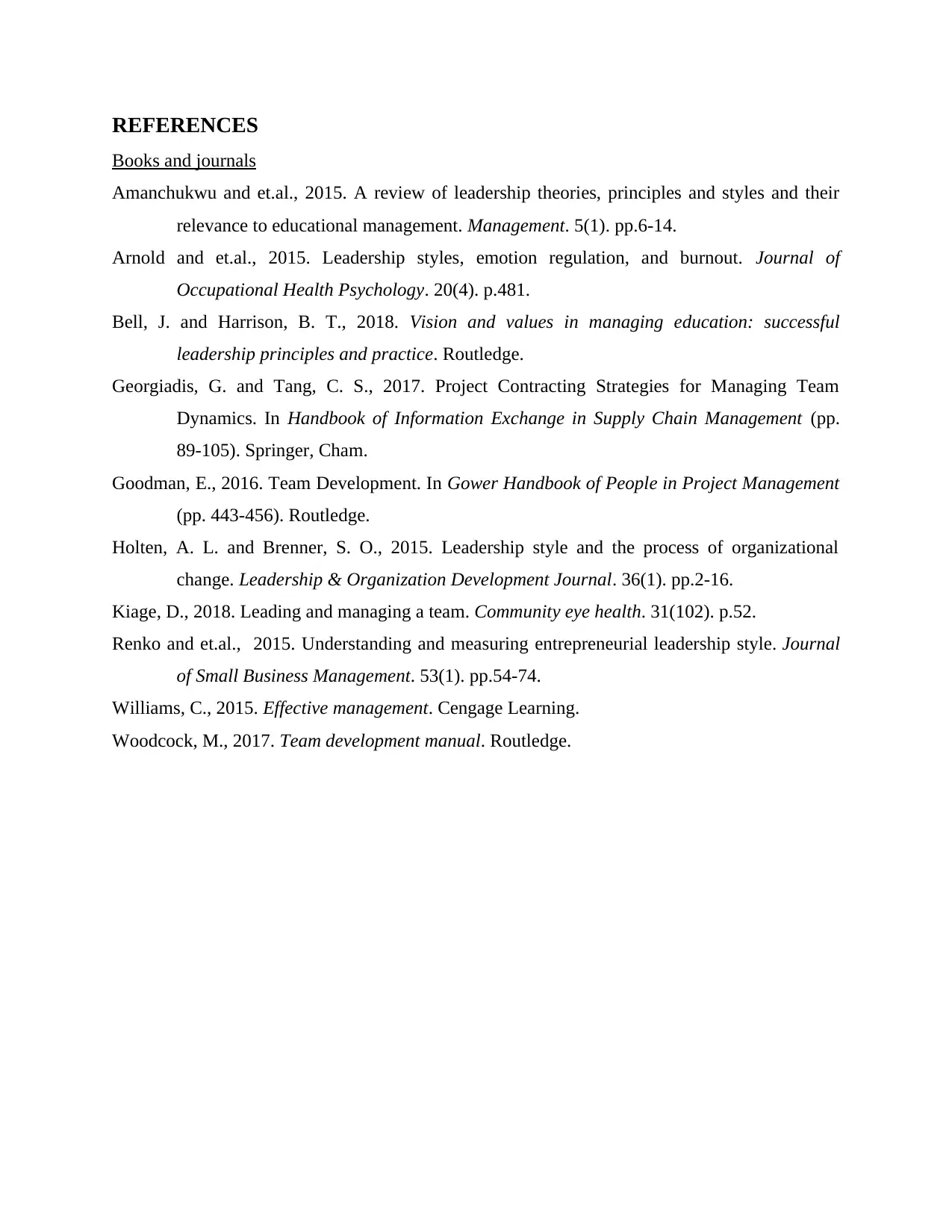
REFERENCES
Books and journals
Amanchukwu and et.al., 2015. A review of leadership theories, principles and styles and their
relevance to educational management. Management. 5(1). pp.6-14.
Arnold and et.al., 2015. Leadership styles, emotion regulation, and burnout. Journal of
Occupational Health Psychology. 20(4). p.481.
Bell, J. and Harrison, B. T., 2018. Vision and values in managing education: successful
leadership principles and practice. Routledge.
Georgiadis, G. and Tang, C. S., 2017. Project Contracting Strategies for Managing Team
Dynamics. In Handbook of Information Exchange in Supply Chain Management (pp.
89-105). Springer, Cham.
Goodman, E., 2016. Team Development. In Gower Handbook of People in Project Management
(pp. 443-456). Routledge.
Holten, A. L. and Brenner, S. O., 2015. Leadership style and the process of organizational
change. Leadership & Organization Development Journal. 36(1). pp.2-16.
Kiage, D., 2018. Leading and managing a team. Community eye health. 31(102). p.52.
Renko and et.al., 2015. Understanding and measuring entrepreneurial leadership style. Journal
of Small Business Management. 53(1). pp.54-74.
Williams, C., 2015. Effective management. Cengage Learning.
Woodcock, M., 2017. Team development manual. Routledge.
Books and journals
Amanchukwu and et.al., 2015. A review of leadership theories, principles and styles and their
relevance to educational management. Management. 5(1). pp.6-14.
Arnold and et.al., 2015. Leadership styles, emotion regulation, and burnout. Journal of
Occupational Health Psychology. 20(4). p.481.
Bell, J. and Harrison, B. T., 2018. Vision and values in managing education: successful
leadership principles and practice. Routledge.
Georgiadis, G. and Tang, C. S., 2017. Project Contracting Strategies for Managing Team
Dynamics. In Handbook of Information Exchange in Supply Chain Management (pp.
89-105). Springer, Cham.
Goodman, E., 2016. Team Development. In Gower Handbook of People in Project Management
(pp. 443-456). Routledge.
Holten, A. L. and Brenner, S. O., 2015. Leadership style and the process of organizational
change. Leadership & Organization Development Journal. 36(1). pp.2-16.
Kiage, D., 2018. Leading and managing a team. Community eye health. 31(102). p.52.
Renko and et.al., 2015. Understanding and measuring entrepreneurial leadership style. Journal
of Small Business Management. 53(1). pp.54-74.
Williams, C., 2015. Effective management. Cengage Learning.
Woodcock, M., 2017. Team development manual. Routledge.
⊘ This is a preview!⊘
Do you want full access?
Subscribe today to unlock all pages.

Trusted by 1+ million students worldwide
1 out of 9
Related Documents
Your All-in-One AI-Powered Toolkit for Academic Success.
+13062052269
info@desklib.com
Available 24*7 on WhatsApp / Email
![[object Object]](/_next/static/media/star-bottom.7253800d.svg)
Unlock your academic potential
Copyright © 2020–2025 A2Z Services. All Rights Reserved. Developed and managed by ZUCOL.





